My first exposure to the existence of something called “a patternmaker’s vise” was in 1978 when I went to work in an actual pattern shop. Although I had been engaged in woodworking at increasingly sophisticated shops for several years by that point, the Emmert vise was unknown to me. My job at the pattern shop was a 7AM-3.30PM shift, which was a struggle for me since I am a night owl by nature and getting up to work on time was a challenge even though it was only a three minute bicycle ride to the foundry from my house. But, that work schedule allowed me to have plenty of afternoon and evening time in the shop I built behind the house.
I was so entranced by the Emmert that I checked into buying a new one from Kindt-Collins, the Cleveland based foundry supplier who was by that time the manufacturer of the original Emmert K1 vise. I cannot recall exactly whether the new one was priced at $1750, $2250, or $2750. All I knew was that there was no way I could afford any of those price points in 1978. I did obtain a pair of Emmerts right after Mrs. Barn and I married and went to Delaware for college in the beginning of 1982. The Philadelphia Navy Yard had recently closed their foundry so there was a huge stash of Emmerts just up the road at a Philly machinery salvage outfit, and I think I paid $200 for my pair.
At least one of mine has always been installed and the center of my workspace ever since. I cannot really imagine a workshop of mine not having one.

Last week my pal JohnR let me know that the Emmert vise may have been rebranded as “the Hopewell vise” and back in production. The information is at the following link. Maybe this is already known throughout the woodworking blogosphere and I have just been too wrapped up in my own activities, but here it is.
CS Machinery (mprime.com)
If you have always wanted a brand new, incomparable patternmaker’s vise this could be your chance. I have no connection to the new maker and have not encountered one of these vises, but I would love to know more myself.
As I once told an aficionado of workbenches, “If you have avoided using an Emmert before, do not start now because you will be black and blue from kicking yourself for not trying it earlier.”
When I blogged ten days ago about the sensation of being thunderstruck at the fellow who brought in a Studelyesque petite Prentiss vise to a recent PATINA gathering I mentioned that I had something sorta similar.

This is it, a charming little piece. It’s a smidge bigger than the prized Prentiss but definitely in the neighborhood. I do not know if any original japanning remains but perhaps one day this winter I will take a swab and solvent to it to find out.
You cannot really see in this picture but the base has been broken through-and-through and remounted to a new metal sub-plate, which is the only reason I could afford it.
I guess those differences really do delineate a $15 vise from a $1500 one.
Recently I was contacted by my friend Justin, who was coming to town to visit his folks. Justin is an enthusiastic and knowledgeable tools collector and broker, and was offering me a piano makers’ vise he had found (actually he has now acquired almost a dozen of them). We spoke on the phone and he sent some pictures and I asked him to bring the best of the lot, which he did.

I bought it, Of course I did. It was practically a moral imperative. It will replace the Sheldon vise on the end of my Studley-replica bench top ASAP. Or, it might go as a face vise on the Sheldon end, diagonal to the existing vise essentially turning this into a partner’s bench.
Stay tuned.

One of the fixtures integral to my ongoing work on building Gragg chairs is this shaving beam I made when embarking down Gragg Boulevard several years ago.
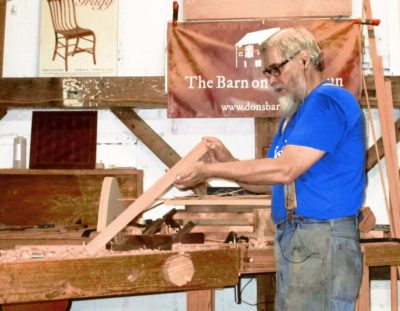
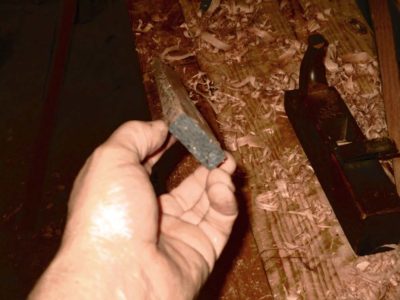
When I am in the heat of battle I need to move back and forth frequently while preparing the stock for the chairs prior to steam bending the elements, checking then by eye and small sizing jig I keep in my pocket or right there on the bench. I found it to be tiresome, and frankly after a while painful, to get up and down from my shaving horse dozens of times a day. Instead I designed and built this fixture that allows me to work on my feet with much less stress to my creaky hips.
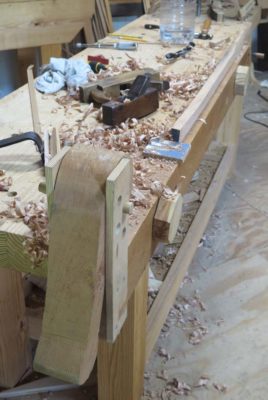
The core of the device is a hunk of 4″ x 6″ Douglas fir from the scrap pile. To that I built a cam clamp head that can grab and hold pieces of split oak (what I normally work with) so that I can shave it close to the final dimension with typical drawknives and spokeshaves, working at waist height while standing.

An additional feature at the other end is a tiny woodscrew clamp with one jaw permanently screwed to the end of the beam. This makes it possible for me to work in both the pulling and pushing directions on the same device. It is nearly effortless to go from pulling a drawknife on a workpiece to switching to pushing either spokeshaves or hand planes getting the piece ready for the steam box.


A series of holes for stops helps hold the workpieces in place while I am yanking on them in one direction of the other.

The entire device is bolted to the rear side of the Roubo workbench I keep up in the video studio on the fourth floor. I drilled 1-1/2″ holes through the beam, then horizontal 1-3/8″ holes in the corresponding location on the edge of the workbench slab. I tapped out the holes in the workbench slab and use threaded Moxon screws through the shaving beam to affix it in place. It can be removed quickly and easily.

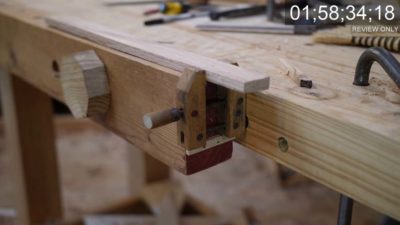
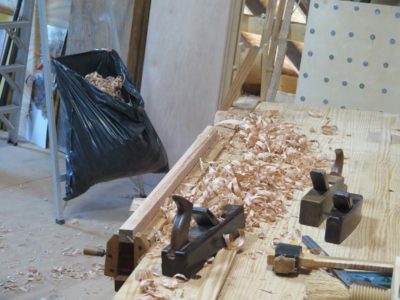
Like I said, this device has become an integral part of making Gragg chairs AND imparting greater speed and comfort to that process. It may not be an overstatement to suggest that this bench accessory has become so important that my passion to continue down the road of making and revising Gragg would be substantially diminished without it.
Once while being visited by an acquaintance who volunteers at a wounded vet rehab facility he noticed that this shaving beam could be made entirely accessible to people in wheel chairs by simply setting it up between trestles rather than attached to the side of a fixed work bench.
Last time I heard from him he was making some for the shop of the rehab facility, and that pleased me even more as it could be one component of regaining healing and wholeness for vets who had sacrificed so much on my behalf.
After returning home from the HO Studley exhibit and reassembling the pastiche workbench I changed my mind about completely rebuilding the base. Though the base I built originally was for the exhibit only, to display the construction of the top slab, I found that it was actually a pretty serviceable structure for the daily use of the top. All it needed was a little more bracing for longitudinal triangulation and it could go to work as an every-day workhorse.

I added a stylistically-appropriate skirt and sure enough it was ready to go. The large uninterrupted flat expanse of the slab made this a favorite for assemblies and related projects where the space was particularly helpful. There was the hole left from mounting one of the piano-maker’s vices for the exhibit, but I could live with that.

Thanks to the generosity of DrDan I had a piano maker’s face vise already in-hand, and augmented with the Shelton vise the bench could be configured to my liking, more or less. The wheel vise remained as installed in the exhibit picture, and the Shelton was used as the end vise.


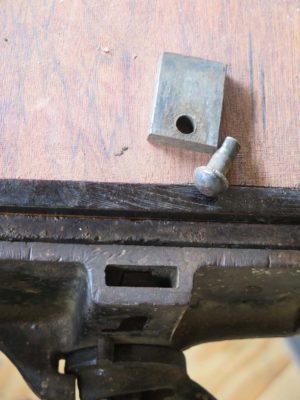
The only down side was that the top was thicker than the Shelton could accommodate in terms of the retractable dog in the moving vise jaw. At this point I had two options; excavate the underside of the bench slab or make and extended dog to project past the top surface. I chose the latter.

I disassembled the dog and replaced it with a new one fabricated specifically to work with the slab thickness. I made the new dog from rosewood.

Installed the vise works just fine, or as fine as a Shelton can. The bench is placed in the geographical center of my shop and gets used on a daily basis, performing its duties skillfully. That is, if an inanimate object can perform, skillfully or otherwise.

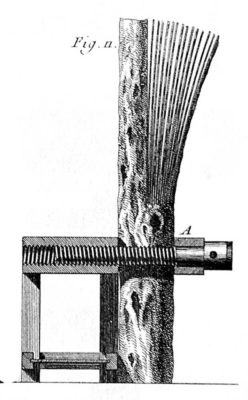
In great part due to the rapidly forming manuscript for To Make As Perfectly As Possible – Roubo On Marquetry and the number of my essays describing the seemingly arcane practices of 18th Parisian workshops, in 2011 I built a slightly diminutive (2/3 scale) version of Roubo’s sawing bench as illustrated in Plate 278, Figures 10 and 11. The dimensions for my version were determined by the space in my basement workshop; I now wish I had made it full sized. Doing so would have doubled the mass of the bench, and in this instance mass is really the only important thing. The construction was real meatball woodworking, I simply fit and fastened together 4×6 tulip poplar stock then drilled holes for the vise screws all the way through the top horizontally. For the female threads I simply used the wooden vise nuts that came with the threaded screws.
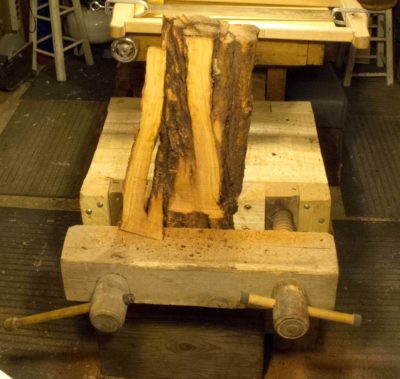
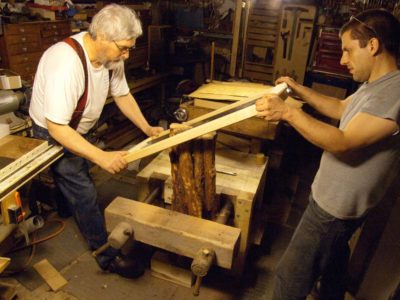
This workbench has only one purpose and function, to hold a work piece firmly while it is being resawn. What we found immediately in battle was that the bench vise did a fine job of holding the work piece in its jaws tightly. Unfortunately the bench was simply too light to perform well in action as the whole thing danced around the shop with every saw stroke. The only way we could get it to work was placing anti-skid pads underneath each leg and then loading it up with as much weight as was handy. Currently this sawing bench is the storage home for several hundred pounds of fire bricks I keep handy.
Roubo alludes to this problem himself, extolling the virtues of massive weights being stored on or under the bench to hold it steady, or even more likely bolting the entire unit to floor. In my old basement shop this made no sense on the concrete floor in a tiny space, it makes more sense now that I have wooden floors and lots of them.

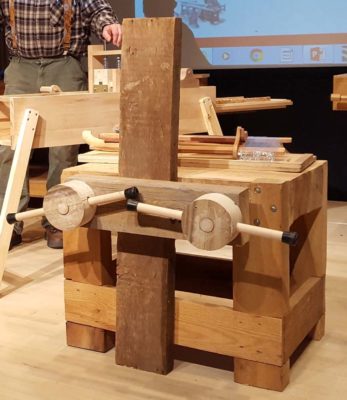

Most recently I used the saw bench during my demo at Working Wood in the 18th Century at Colonial Williamsburg, employing an attendee as my stabilizing weight. In preparation for that demo, and in response to my having cannibalized the unit to use the original vise screws on other benches, I made new screws and screw nuts with my Bealle threading unit.
I cannot say I have used this bench enough to become facile at resawing veneer, the best I can do is about eight leaves per inch. Only time will tell if I ever get to the point where I can saw a dozen leaves to the inch like the old timers, but if I do this bench or one like it will be part of the equation.

Before I move forward to discuss the next workbench in my inventory let me be diverted to discuss the retro-fitting of a previous bench, my Smithsonian Roubo, such that its location, role and function in the studio are completely new and immensely more valued. Over time the bench had come to occupy the end of the classroom space, primarily because it was the only bench I had that could fit there. It was not really large enough to suffice as a student bench for workshops so instead I employed it primarily for metal-working type projects including saw making and sharpening, hardware mounting, parts fabrication, etc. (sorry for the lousy picture; I had already removed the leg vise for another bench, replacing it here with a Record 53)
When I recently removed the generic end vise and mounted instead the ~125 lb. Emmert Universal Vise in its place, one piece of a convoluted equation began to take shape. I knew the vise needed a robust platform and this little-used bench performs the function perfectly.
A second element in this equation was expanding the work space on the side of the barn housing my shop; I reorganized it so that my own shop would extend an additional nine feet to include the full footprint of the 14′ x 36′ bay in the timber frame. (Of course that meant that I needed more workbenches there. Stay tuned on that one.)
A third component in the equation was a beloved niece-in-law had expressed an interest in learning woodworking (actually I have four beloved nieces-in-law, but this is one in particular). The odds are pretty good the second of the petite Roubos I built originally for my Handworks booth would eventually end up in their apartment. So, I removed it from the critical space it occupied adjacent to my third child before it became too disruptive to do so. I moved that little bench down into the newly opened space, for the time being.
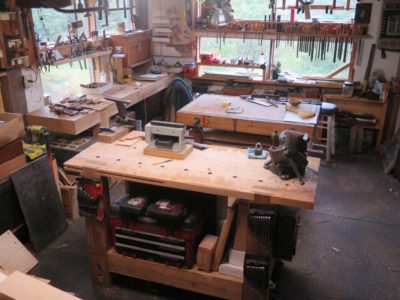

Since nature abhors a vacuum something needed to go into that space previously occupied by the petite Roubo. Hmm, I really did like having a metalworking-ish bench in the middle of my herd of woodworking benches… Palm, meet forehead. Soon I had the old, almost extraneous Roubo bench relocated, revived and recommissioned, sitting where it will be used daily. I removed the second vise and stocked the space underneath with a lot of my mechanicky tools.
I have additional plans for this bench which I will chronicle when they unfold.
Here is a gallery of the Emmert Universal Vise showing off its moves.
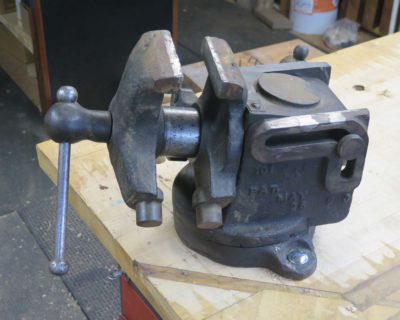
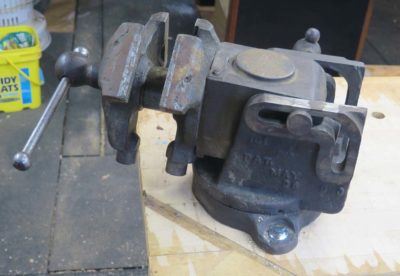
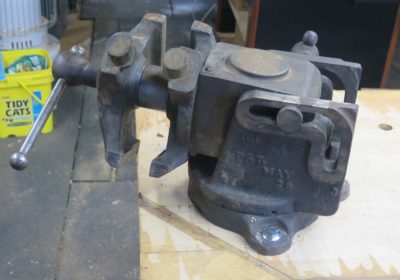
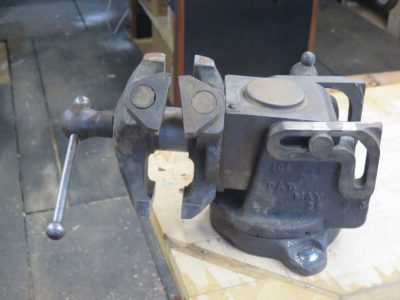
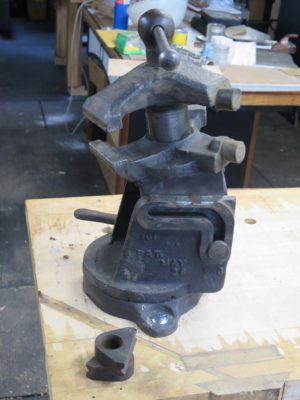
For many years I have been on the hunt for a most rare quarry, the Emmert Metalworker’s Vise. As a life-long aficionado of Emmert K1 Patternmaker’s Vises, well, maybe not my whole life but certainly since I joined the Maddox Foundry pattern shop in 1978, I have found the K1 to be something close to a perfect woodworking vise. By that time Emmert Company was long gone but Kindt-Collins, the foundryman’s supply house, was manufacturing them. I was so taken by the vises in the pattern shop that I checked into buying the K-C version. The price of almost $2k in 1980 scared me off but I was indeed hooked.

Fortunately in 1982 I was able to buy a pair of vintage K1s at a price a married college student could afford. They sat unused for three years until I finished school, got a job, a house with a basement shop, and a workbench to put one on. This has been my constant woodworking companion ever since. (My second one waits forlornly for a bench of its own.) As I have often said to my well-established woodworking friends, “If you have never used an Emmert K1 don’t start now because you will be black-and-blue from kicking yourself for waiting so long.”
I am ashamed to admit that I never learned of the Emmert “Tool Maker’s and Metal Worker’s Vises” a/k/a “The Metal Hand” until a decade or so ago. If Emmert’s woodworking vise was this good, how fantastic must be their metal working vise? I was now on the hunt for this great beast.
Occasionally they would come up at auctions or on-line, but the prices, like that of the Kindt-Collins K1, were enough to retard but not diminish my ardor. It seemed as though every time the prices would eventually zoom into the stratosphere and I would have to drop out. A few years ago at Donnelly’s I hung in on the bidding long past my point of reason and still the hammer price was twice as much as when I dropped out.
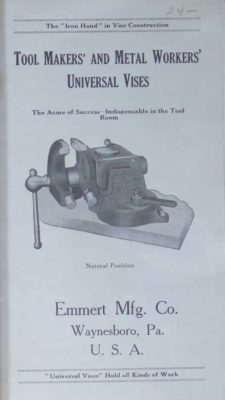
As a profound gesture of friendship and condolence in the aftermath of my dashed hopes, my friend Jersey Jon presented me with a consolation prize, an equally rare but far less expensive (I hope) product brochure for the vise. It remains a treasure in the Archive of Don.
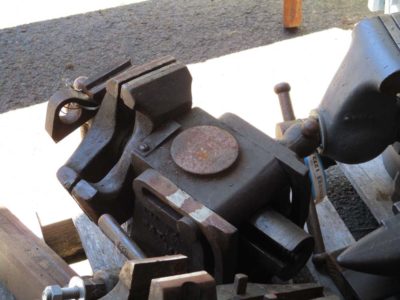
With high hopes I noticed one in this year’s MJD Summer Auction catalog and the chase was on. I knew from the listings that this item would be on the block at lunch time on Saturday. I located and examined the vise almost immediately on arriving on Thursday, and from that point on all the auction activity pointed to lot 26XX (at the moment I cannot recall the number).
When the moment was approaching our little band of tool mavens quieted down in anticipation of the lot number. Once it began it was soon clear that only one other bidder was fervently interested. As fate would have it he and I both had the same secret limit and fortunately I got there first! The auctioneer sang out the next increment several times then said “Sold to number 78.” With whoops and back slaps I was the winner, and unlike Captain Ahab I was going to live with my conquest.
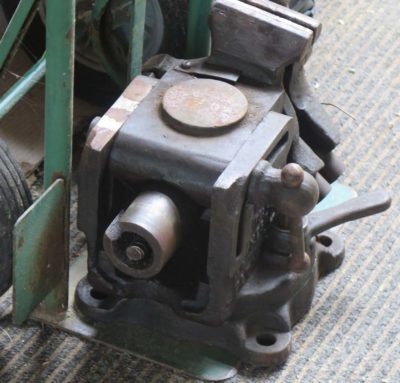
Afterwards we loaded it into the CRV with some effort. At home I wrestled it to the ground, not much of a contest as it weighs more than a hundred pounds. The trick was avoiding smashing my toes or aggravating my back. Once on the hand truck it was a piece o’ cake to wheel it into the shop, and with caution I hoisted it onto my bench to remove the grease and grime.
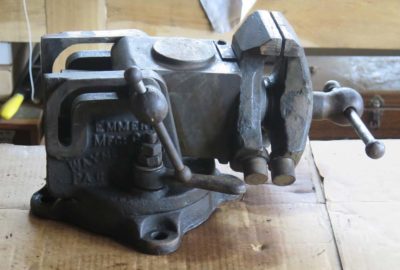
And there it sits to this moment, awaiting a plan to mount it, perhaps on a new bench.
In hindsight I wonder if landing this beast after such a long quest will diminish my enthusiasm for attending tool gatherings like the one where I obtained it.
Nah, that’s just crazy talk.
But like Jameel Abraham once quipped to me, “Why couldn’t we collect thimble boxes instead of cast iron anchors?”
While noodling around the shop getting the classroom and supplies ready for the upcoming (actually, just-completed) “Make A Petite Dovetail Saw” workshop I devised and built several of perhaps the easiest and simplest saw filing vise ever. Like me you can make one in minutes using materials from the scrap box.
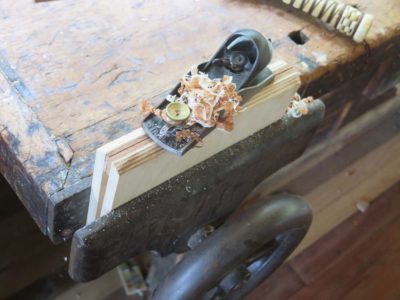
I started with some 1/2″ baltic birch cut into a pair of 6″ x 8″ panels. These were connected together along one of the long edges with a piece of piano hinge, with about 1/8″ space between the panels when the hinges were screwed on. Following this a pair of scrap strips approx. 1/8″ thick were glued to the inside edge at the tops (the hinge was on the bottom). Once the glue was dry I trimmed the top edges with a block plane until they were clean.
The result was a wooden book facsimile that was narrower at the bottom than at the top. This would be important later on.
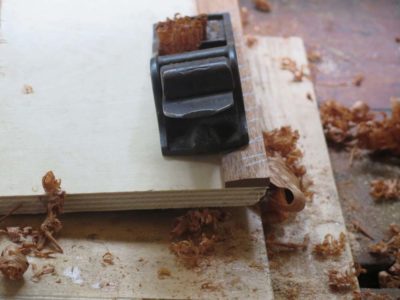

With these top strips in place along the inside edge and the glue hard I planed a chamfer along the bottom of each of them to create bevels that touched at the top of the vise, thus bringing it into intimate contact with the saw plate being sharpened. At this point the vise is finished. Really.
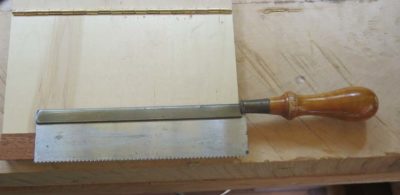
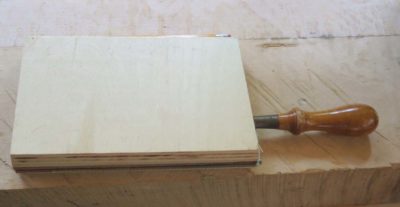
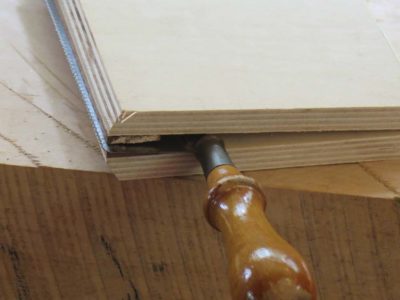
In operation the vise is pretty much idiot proof. Place the saw in the “book” so that the teeth are exposed by the amount you want. I generally shoot for a tad more than the distance between the teeth, but you can use what ever is convenient and comfortable.
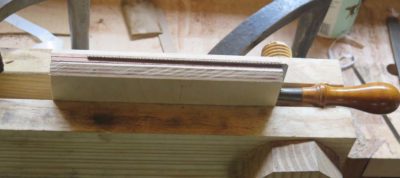
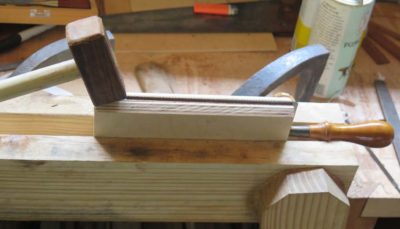
The vise with the saw inside are gently pinched together and placed in a bench vise, a Moxon in this case but any vise that fits is an option. By adjusting the Moxon vise such that the thinner bottom of the saw vise slips into it easily yet the saw vise engages with the Moxon jaws a little more than halfway in, this seems to work perfectly. Press down on the saw vise until it is snug in the Moxon and fully engaged with the saw plate. A gentle tap on the top of the saw vise drives it deeper into the Moxon and causes the saw vise to pinch the saw plate so that it can be filed.
When you are finished with a filing run a 3/4 turn of the screws loosens the Moxon enough to allow the saw vise to be easily lifted out of the Moxon.
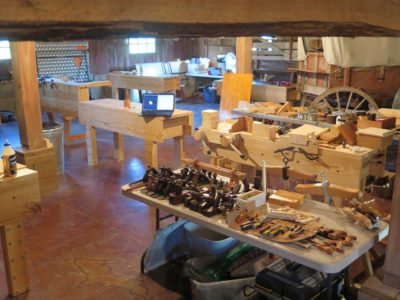
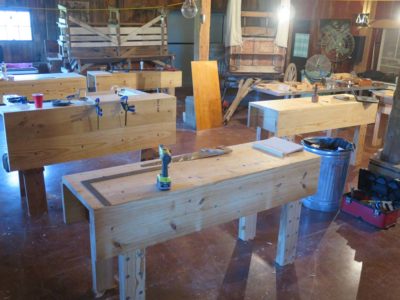
On the syllabus for Day 2 was to finish up the workbenches quickly and get started on the initial pair of pratica, namely the winding sticks and the planing stop. But in the lull of battle preceding the gathering of the students I reveled in just walking around, admiring their productivity yesterday.
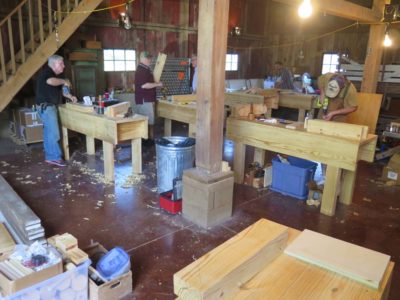
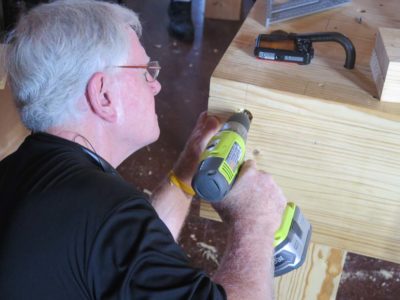
The benches soon received their finishing touches of holdfast holes and threaded aprons to accept the screws for the vises. I learned after the fact that a good drilling jig would have been very helpful for these holes. A few of them were slightly off kilter, and a good jig would have saved a lot of headache in the end. I’ve already got the design in mind and will fabricate it as soon as I get home.

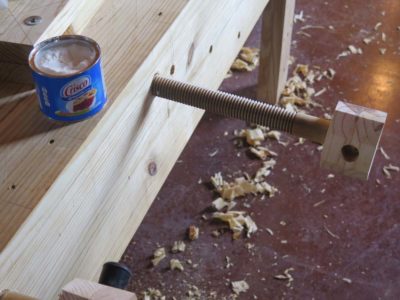
Soon the holes were drilled and threaded and the screws lubricated and tested in them.
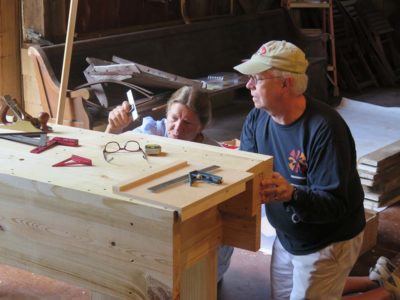
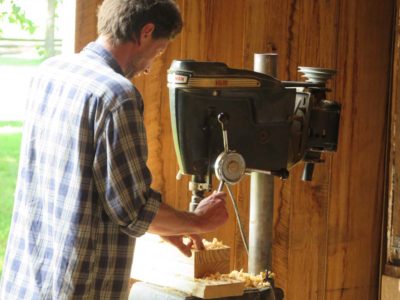
The double-thick jaws were laid out and drilled with a drill press that was brought over from the shop and the vises installed.
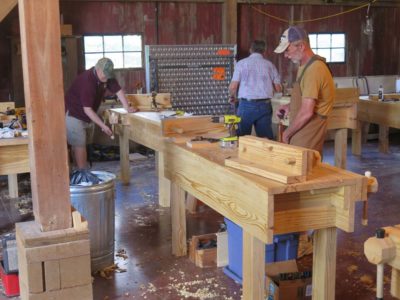
After this the Moxon vises were a cakewalk.
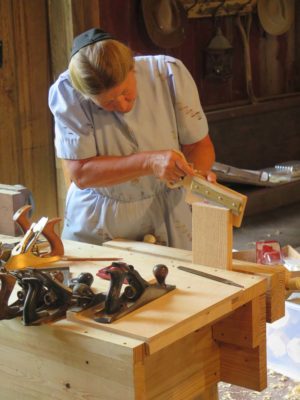
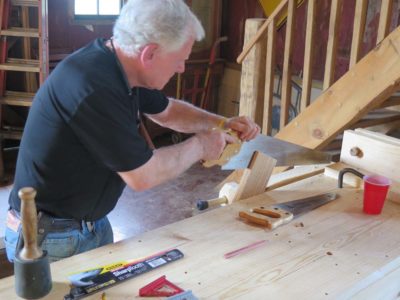
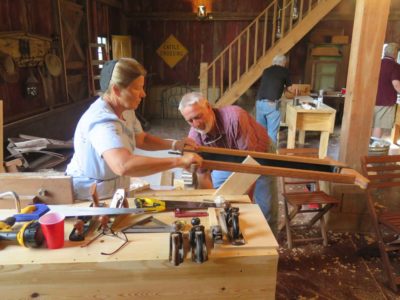
The benches were then given their first real workouts with the resawing, ripping, and crosscutting of the pieces for the winding sticks and planing stop. All variety of saws were employed, with my giant c.1800 two-man frame saw the the new Bad Axe version receiving great acclaim.
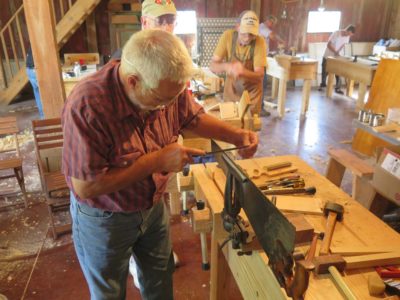
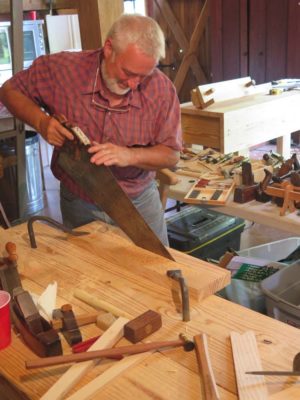
One of my treats for the day was giving Cam a lesson on saw sharpening. He’d finished up his work in the metal shop for the day and dropped in to see what we were up to. Being a skilled metal worker Cam took to it like a fish to water and the results were gratifying.

This is one of my favorite images for the week, with husband and wife working alongside each other in their own tasks. A profound model for us all.


































































Recent Comments